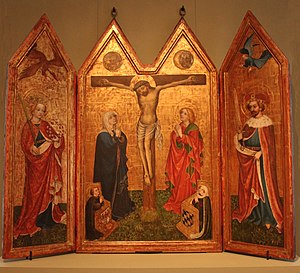Cadolzburg Altar

|
| Cadolzburg Altar |
|---|
| Master of the Cadolzburg Altar , 1425–1430 |
| Tempera on spruce wood |
| 161.5 × 97.8 (middle part) cm |
| Grunewald Hunting Lodge , Berlin |
The Cadolzburg Altar by the master of the same name was made between 1425 and 1430. The middle part and two side panels of the triptych are in the Grunewald hunting lodge , two other side parts with the saints Urban and Sigismund were burned in Cadolzburg .
Client, origin and history
When the first Elector of Brandenburg Friedrich I withdrew to the Hohenzollernburg Cadolzburg, 20 km west of Nuremberg, in 1426 , he commissioned an altarpiece for the parish church of Cadolzburg, which is dedicated to St. Cäcilia .
The altar was first mentioned in 1606. During the restoration in 1662 the altarpiece was painted over. In 1750 the altar came to the rectory when the church was demolished and rebuilt. In 1854 it was rediscovered in the Zehntscheune in Cadolzburg and published by Julius von Minutoli as part of his studies on the history of the Hohenzollern and Brandenburgs. In 1873 the altar was given to the then Crown Prince Friedrich III. Donated by the parish church of Cadolzburg because of his urgent request and his interest in the images of the donor figures. It was restored in 1902 and 1931. First he was then in the office of the Crown Prince in the Crown Prince's Palace on Unter den Linden . He then came to the Hohenzollern Museum Schloss Monbijou and, after the First World War, to the Berlin Palace .
The motif
A crucifixion scene with Mary and Saint John as well as the early Christian martyrs Cäcilia and Valerianus and the donor couple Friedrich and Elisabeth von Bayern-Landshut are depicted , who kneel in prayer chairs in the corners of the picture in the middle.
On the outer wings of the altar a scene of the Annunciation is shown in grisaille technique.
The representation
Saint Cecilia is depicted on the left with the palm fronds of the martyrs and on the right her bridegroom Valerias in electoral regalia and imperial sword in hand, which here also indicates his martyr's death. Mary is depicted on the left, i.e. on the heraldically higher right side, together with Frederick I and the golden sun, whereas St. John, Elisabeth and the image of the moon are on the right half of the picture. The painter hardly allows any deviations from the strictly symmetrical picture structure. The turning of the head and body of Christ to the left towards Mary in the so-called soft style are balanced by the tip of the loincloth overhanging to the right.
Elector Friedrich von Brandenburg and his wife Elisabeth, whose main residence was the Cadolzburg, can be clearly identified by the time the altar was built and the coats of arms of Zollern and Bavaria attached to the prayer chairs. Friedrich only received the coat of arms of the red Brandenburg eagle in 1417 at the Council of Constance through enfeoffment with the Electorate of Brandenburg.
The pointed gable form of the Nuremberg painting is unusual, as it can also be seen on the Deokarus altar from 1436/37 from St. Lorenz in Nuremberg , which provides further dating aid.
See also
literature
- Carl Gebhardt: The master of the Cadolzburg altar . In: The beginnings of panel painting in Nuremberg . Heitz & Mündel, Strasbourg 1908, p. 44 ff . ( archive.org ).
- Helmut Börsch-Supan : 450 years of Grunewald Hunting Lodge. II. From the painting collection. Master of the Cadolzburg Altar. State Palaces and Gardens Berlin 1992.
Web links
Individual evidence
- ↑ Cadolzburg Altar. hdbg.de, accessed on October 3, 2018 .
- ↑ The Cadolzburg Altar and the Hohenzollern. In: SPSG Blog. Prussian Palaces and Gardens Foundation Berlin-Brandenburg, accessed on October 3, 2018 .


